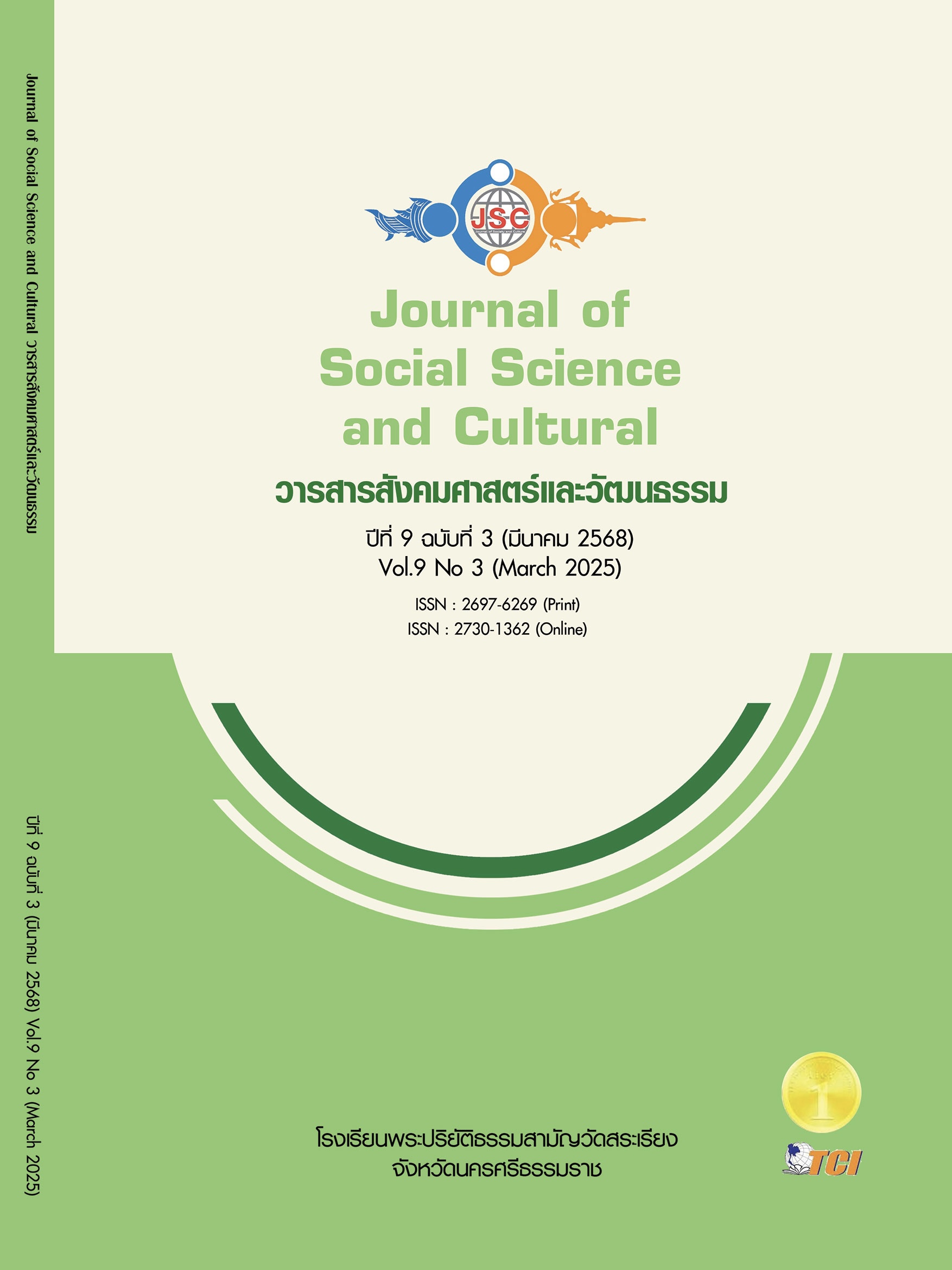รูปแบบพัฒนาเด็กพิเศษในศตวรรษที่ 21 โดยใช้สามฐานโมเดล สำหรับโรงเรียน เรียนรวมระดับประถมศึกษาของจังหวัดชัยนาท
Main Article Content
บทคัดย่อ
การศึกษานี้มีวัตถุประสงค์เพื่อพัฒนารูปแบบการพัฒนาเด็กพิเศษในศตวรรษที่ 21 โดยใช้สามฐานโมเดล สำหรับโรงเรียนเรียนรวมระดับประถมศึกษาของจังหวัดชัยนาท การวิจัยนี้ใช้ระเบียบวิธีวิจัยและพัฒนา (Research and Development) ซึ่งดำเนินการ 4 ขั้นตอน ได้แก่ 1) ศึกษาและวิเคราะห์ข้อมูลพื้นฐาน 2) ออกแบบและพัฒนารูปแบบ 3) ทดลองใช้รูปแบบ และ 4) ประเมินผลการใช้รูปแบบ ผู้ให้ข้อมูลสำคัญ ได้แก่ ผู้เชี่ยวชาญ 3 คน ที่มีประสบการณ์เกี่ยวกับการจัดการเรียนการสอนแบบเรียนรวม การพัฒนารูปแบบการเรียนการสอน ผู้บริหารสถานศึกษา 8 คน ครู 8 คน และผู้ปกครองของต้นแบบโรงเรียนเรียนรวม จังหวัดชัยนาท 8 คน รวมผู้ให้ข้อมูลสำคัญ จำนวน 24 คน โดยการเลือกแบบเจาะจง (Purposive Sampling) กลุ่มตัวอย่าง ได้แก่ ผู้บริหารสถานศึกษา 83 คน ครู 166 คน นักเรียน 166 คน ผู้ปกครอง 83 คน รวม 498 คน โดยการคำนวณขนาดกลุ่มตัวอย่าง Krejcie & Morgan และได้กลุ่มตัวอย่างจากการสุ่มอย่างง่าย (Simple Sampling) การวิเคราะห์ข้อมูลใช้สถิติพื้นฐาน ได้แก่ ร้อยละ ค่าเฉลี่ย ส่วนเบี่ยงเบนมาตรฐาน และการวิเคราะห์เนื้อหา ผลการวิจัยพบว่า 1) ข้อมูลพื้นฐาน ครู ผู้ปกครอง และชุมชน ไม่เข้าใจระบบการเรียนรวม และขาดสื่อและแหล่งเรียนรู้ที่เหมาะสม 2) การออกแบบและพัฒนารูปแบบ ใช้หลักไตรสิกขา (ศีล สมาธิ ปัญญา) การวิเคราะห์พฤติกรรมประยุกต์ (ABA) และการเรียนรู้แบบรวมพลัง (Collaborative Inclusive Education) โดยรูปแบบมี 5 องค์ประกอบ คือ หลักการ จุดมุ่งหมาย เนื้อหา กิจกรรมการเรียนการสอน และการวัดผล 3) ทดลองใช้รูปแบบ พบว่า ทักษะในศตวรรษที่ 21 ของเด็กพิเศษเพิ่มขึ้นอย่างมีนัยสำคัญทางสถิติ โดยเฉพาะทักษะการเรียนรู้ การใช้ชีวิต และการสื่อสาร และ 4) ประเมินผล พบว่า รูปแบบนี้มีความเหมาะสมและความเป็นไปได้ในระดับมากที่สุด ผู้เข้าร่วมมีความพึงพอใจในระดับมาก
Article Details
เอกสารอ้างอิง
ทิศนา แขมมณี. (2555). ศาสตร์การสอน: องค์ความรู้เพื่อการจัดกระบวนการเรียนรู้ที่มีประสิทธิภาพ. กรุงเทพมหานคร: จุฬาลงกรณ์มหาวิทยาลัย.
ธีระ รุญเจริญ. (2550). ความเป็นมืออาชีพในการจัดและบริหารการศึกษา ยุคปฏิรูปการศึกษา. (พิมพ์ครั้งที่ 4). กรุงเทพมหานคร: ข้าวฟ่าง.
พระพรหมคุณาภรณ์ (ป.อ. ปยุตฺโต). (2553). พุทธธรรม. กรุงเทพมหานคร: สำนักพิมพ์มหาวิทยาลัยมหาจุฬาลงกรณราชวิทยาลัย.
สาวิตรี เถาว์โท. (2558). การพัฒนารูปแบบการเรียนการสอนตามแนวคิดการเรียนรู้ แบบผสมผสานรายวิชาภาษาอังกฤษเพื่อการสื่อสารข้ามวัฒนธรรม สำหรับนักศึกษาปริญญาบัณฑิตมหาวิทยาลัยราชภัฏ. ใน ดุษฎีนิพนธ์ปรัชญาดุษฎีบัณฑิต สาขาวิชาวิจัยหลักสูตรและการสอน. มหาวิทยาลัยราชภัฏสกลนคร.
สำนักงานคณะกรรมการการศึกษาขั้นพื้นฐาน. (2561). รายงานสถานการณ์การศึกษาสำหรับเด็กพิเศษในประเทศไทย. กรุงเทพมหานคร: กระทรวงศึกษาธิการ.
สำนักงานคณะกรรมการการศึกษาขั้นพื้นฐาน. (2563). ข้อมูลนักเรียนพิการเรียนรวมในปี พ.ศ. 2563. เรียกใช้เมื่อ
กรกฎาคม 2564 จาก http://specialbasic.specialset.bopp.go.th/specialbasic/download/studentall_deform_2563_1.pdf
สำนักงานเลขาธิการสภาการศึกษา. (2563). นโยบายและแนวทางการศึกษาสำหรับเด็กพิการในประเทศไทย. กรุงเทพมหานคร: กระทรวงศึกษาธิการ.
อนุชิต บุญมาก. (2560). การพัฒนาแนวทางการจัดการเรียนร่วมสำหรับสถานศึกษา สังกัดสำนักงานเขตพื้นที่การศึกษาประถมศึกษาอุดรธานี เขต 1. ใน วิทยานิพนธ์การศึกษามหาบัณฑิต สาขาวิชาการบริหารการศึกษา. มหาวิทยาลัยมหาสารคาม.
Cooper, J. O. et al. (2020). Applied Behavior Analysis. Boston, MA: Pearson.
Friend, M. & Bursuck, W. D. (2019). Including Students with Special Needs: A Practical Guide for Classroom Teachers. Boston, MA: Pearson.
Kruse, K. (2008). Introduction to Instructional Design and the ADDIE Model. Pathum Thani: e-Learning Guru.
OECD. (2018). The Future of Education and Skills: Education 2030. Paris: OECD Publishing.
UNESCO. (2020). Education for All. Retrieved July 1, 2021, from https://en.unesco.org/themes/education-all.


